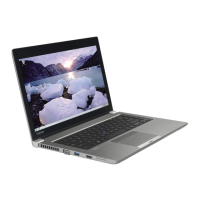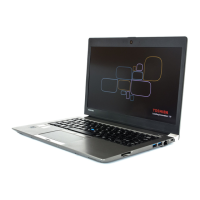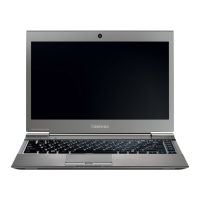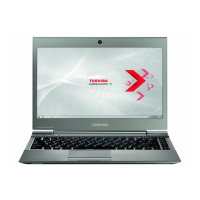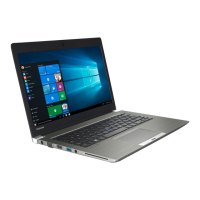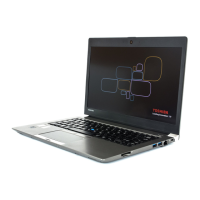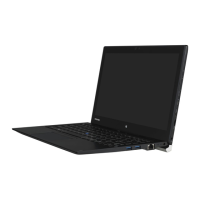
Do you have a question about the Toshiba Z40-B and is the answer not in the manual?
| Graphics | Intel HD Graphics 4400 |
|---|---|
| Wireless | Wi-Fi 802.11ac, Bluetooth 4.0 |
| Processor | Intel Core i5 or i7 |
| RAM | Up to 16GB DDR3L |
| Storage | 256 GB SSD |
| Display | 14-inch, 1920 x 1080 |
| Operating System | Windows 8.1 Pro |
| Weight | 1.47 kg (3.24 lbs) |
| Battery Life | Up to 9 hours |
| Ports | USB 3.0, HDMI, VGA, Ethernet |
| Security | TPM, Fingerprint Reader |
Details copyright, disclaimer, and trademark information for the manual and computer.
Covers FCC notice, EU Declaration of Conformity, and CE compliance details for the device.
Information specific to Canadian regulations regarding radio noise emissions from digital apparatus.
Guidance on proper disposal of products and batteries according to EU regulations.
Instructions for disposing of batteries and accumulators, including symbol explanations.
Statement regarding compliance with the EU REACH chemical regulation.
Legal notice concerning the licensing of video standards used in the product.
Information about the computer's compliance with the ENERGY STAR program for energy efficiency.
Guidance on how to dispose of the computer and its non-user-accessible battery pack.
General safety precautions for operating the computer to minimize risk of injury or damage.
Instructions on ensuring proper ventilation for the computer and AC adapter to prevent overheating.
Advice on setting up a work area to protect the computer from environmental hazards.
Guidance on preventing stress injuries from extensive keyboard use and proper workspace setup.
Precautions regarding prolonged contact with a warm computer or AC adapter to prevent heat injury.
Warning against applying heavy pressure or impact to the computer to prevent damage.
Instructions on how to safely clean the computer and its display screen.
Precautions to take when moving the computer to ensure trouble-free operation.
Information on potential interference between mobile phones and the computer's audio system.
Explanation of safety icons used in the manual to highlight important warnings and notes.
Lists the hardware and documentation items to check after unpacking the computer.
Explains the formats and symbols used in the manual for clarity and consistency.
Defines the shortened model names used for the computer throughout the manual.
Provides basic information and precautions for initial computer setup and use.
Detailed instructions on how to connect the AC adapter for power and charging.
Instructions on how to open the computer's display panel safely and adjust its angle.
Steps for turning on the computer, including initial setup and power indicator information.
Guidance on the Windows Startup Screen and the initial operating system setup process.
Information on navigating and using the Windows operating system features.
Explains how to turn off the computer using Shut Down, Sleep, or Hibernation modes.
Details on system recovery options, including creating recovery media and restoring the system.
Identifies front components of the Z30-B model with the display closed.
Identifies ports and indicators on the left side of the Z30-B model.
Identifies ports and slots on the right side of the Z30-B model.
Identifies cooling vents on the back of the Z30-B model.
Identifies cooling vents and docking port on the underside of the Z30-B model.
Identifies front components of the Z30-B model with the display open.
Identifies front components of the Z40-B model with the display closed.
Identifies ports and cooling vents on the left side of the Z40-B model.
Identifies ports and slots on the right side of the Z40-B model.
Identifies cooling vents on the back of the Z40-B model.
Identifies cooling vents and docking port on the underside of the Z40-B model.
Identifies front components of the Z40-B model with the display open.
Describes internal hardware components like battery pack and CPU.
Explains the meaning of different indicator lights for power and battery status.
Explains basic touch screen gestures like tap, press and hold, pinch, rotate, and slide.
Details touch pad gestures including tap, two-finger tap, pinch, and scroll.
Describes keyboard layout, CAPS LOCK indicator, and function keys.
Lists key combinations for function keys (F1-F12) and their actions.
Explains special Windows keys like the Start menu and context menu keys.
Instructions on how to use the AccuPoint pointing device and its control buttons.
Details on enrolling and recognizing fingerprints for authentication and security.
Recommended steps for swiping fingers for accurate fingerprint registration or authentication.
Important considerations and precautions for using the fingerprint sensor to avoid damage or errors.
Procedure for setting up fingerprint authentication for the first time.
Instructions on how to delete fingerprint data for the current user or all users.
Overview of battery types, use, recharging methods, and handling precautions.
Information on battery charging procedures and the DC IN/Battery indicator.
Methods for monitoring the remaining battery power and operating time.
Factors affecting battery life and tips for maximizing operating time.
Information about the Wireless WAN device and how to install a SIM card.
Step-by-step instructions for installing a SIM card into the computer.
Instructions on how to properly remove a SIM card from the computer.
Information about the built-in GPS functionality and its performance variations.
Details on connecting to a Local Area Network (LAN), including cable types.
Information about memory media slots and types of memory media supported.
Guidance on how to format memory media cards correctly.
Precautions and guidelines for handling and caring for memory media cards.
Step-by-step instructions for inserting memory media into the computer's slot.
Instructions on how to safely remove memory media from the computer.
Information on Smart Cards, their use, and the Smart Card slot.
Instructions for inserting a Smart Card into the computer's slot.
Information on connecting external displays to enhance video capabilities.
Steps for connecting external displays via RGB and HDMI ports.
Details on using the HDMI out port for digital video and audio transfer.
Information on using wireless display technology to connect to external screens.
Details on the TOSHIBA Hi-Speed Port Replicator and its connectivity.
Instructions on connecting a security cable to prevent unauthorized removal or theft.
Lists optional accessories available for enhancing computer functionality.
Describes audio control functions like Volume Mixer, Microphone Level, and Audio Enhancements.
Information on the DTS Studio Sound audio enhancement suite.
Describes pre-installed utilities and how to start them for enhanced computer functionality.
Utility for configuring display modes, monitors, and image enhancements.
Utility to set and manage passwords for restricting computer access.
Utility for customizing hardware settings and system configurations.
BIOS setup utility to view and change BIOS settings.
Utility for managing power consumption and optimizing battery life.
Application for automatic search and installation of TOSHIBA software updates.
Monitors system functions like power, battery health, and cooling.
Tracks system activities for product improvement and development.
Utility for audio source filtering and enhancement.
Allows using the computer as a Bluetooth keyboard/mouse or for smartphone operation.
Utility to erase internal storage, delete partitions, and overwrite sectors.
Recording application for analyzing voices and marking statements in recordings.
Highlights unique or advanced features for convenient computer use.
Feature to automatically cut power to the display panel after inactivity.
Feature to cut power to the internal storage drive when not accessed.
Automatically shuts down the system into Sleep or Hibernation Mode after inactivity.
Provides two levels of password security for preventing unauthorized access.
Microprocessor detects battery charge and protects components from abnormal conditions.
Configures the computer to save battery power.
Automatically turns power off when the display panel is closed and back on when opened.
Automatically enters Hibernation Mode when battery power is exhausted.
Allows turning off power without exiting software, maintaining data in memory.
Saves main memory contents to storage drive to resume work later.
Restores computer from Sleep Mode using USB devices.
Manages processor temperature by controlling fan speed or processing speed.
Utility for registering, deleting, and changing user passwords.
Utility to set a Supervisor Password for restricting functions for general users.
Procedure for manually entering a password when starting the computer.
Allows computer to supply USB Bus power to USB ports for charging devices.
Enables charging of USB devices even when the computer is turned off.
Enables rapid USB battery charge when the computer is powered on.
Monitors system functions, providing notifications on system conditions.
Tracks system activities for product improvement and development.
Reduces risk of HDD damage by detecting vibration and parking the head.
How to change HDD Protection settings and detection levels.
Displays HDD Protection status icons in the Taskbar.
Sets sensitivity levels for detecting vibrations and impacts.
Displays a 3D object representing the computer's internal HDD.
Guidelines for identifying and resolving computer problems effectively.
Basic checks for common issues like peripheral connections and driver software.
Questions to consider when diagnosing computer malfunctions.
Troubleshooting steps for problems related to software or disk media.
Steps for troubleshooting hardware issues after ruling out software problems.
Procedure for handling unresponsive keyboard commands by restarting the computer.
Steps to close a program that has frozen without shutting down the system.
Checks for power connections and outlet function if the computer does not start.
How to load advanced options like Setup Utility or Boot menu during startup.
Discusses problems related to hardware and peripherals like power, keyboard, and USB.
Procedure for computer shutdowns due to high processor temperature.
Troubleshooting steps for AC power issues, checking the DC IN/Battery indicator.
Troubleshooting battery issues, including charging and power problems.
Troubleshooting when BIOS settings and system date/time are lost.
Troubleshooting keyboard problems related to setup, configuration, or output.
Troubleshooting apparent problems with the computer's display panel.
Troubleshooting slow performance issues related to the Hard Disk Drive.
Troubleshooting issues with memory media cards, including errors and write protection.
Troubleshooting issues with Touch Pad and USB mouse operation.
Troubleshooting problems with USB devices not working or with the Sleep and Charge function.
Troubleshooting issues related to sound, including no sound or annoying sounds.
Troubleshooting external monitor issues like no display or display errors.
Troubleshooting LAN connectivity issues, such as inability to access the network.
Troubleshooting Wireless LAN connectivity problems.
Troubleshooting issues with connecting to Bluetooth devices.
Information on how to obtain additional help and technical assistance from TOSHIBA.
Summarizes the technical specifications of the computer, including physical dimensions.
Provides physical dimensions for Z30-B and Z40-B models.
Details operating and non-operating environmental conditions like temperature and humidity.
Specifies power requirements for the AC adapter and computer.
Pin assignment details for the external RGB monitor port.
Information on AC power cord compatibility, wire size, current rating, and certification agencies.
Lists certification agencies for various countries and their standards.
Covers wireless technology interoperability, health considerations, and LAN technology.
Compatibility of Wireless LAN and Bluetooth with other systems.
Addresses health considerations related to radio frequency energy emitted by wireless products.
Details on wireless LAN communication function and its limitations.
Specifies radio frequency bands and their usage restrictions.
Requirements regarding radio frequency interference for indoor use.
Regulations for using 2.4GHz and 5GHz frequencies in Europe and other regions.
Information on compliance with Industry Canada rules for digital apparatus.
Information on FCC compliance for Class B digital devices.
Warning about potential human contact during normal operation of wireless devices.
Restriction on device use for indoor operation due to frequency range.
Compliance information for Australia and New Zealand regarding radio transmitting devices.
Important notices and indications for wireless LAN and Bluetooth use in Japan.
Authorization details for wireless devices and applicable restrictions.
Details on Intel® Active Management Technology (AMT) support and configuration.
Procedure to disable the Intel AMT function to prevent potential security risks.
Provides legal footnotes regarding CPU performance, 64-bit computing, and memory.
Legal footnotes on CPU performance variations and automatic shutdown conditions.
Information on compatibility of 32-bit drivers/applications with 64-bit systems.
Explanation of how main system memory is used and displayed.
Factors affecting battery life and published battery life numbers.
Explanation of storage capacity definitions and factors affecting displayed capacity.
Information on LCD screen brightness deterioration and power mode dimming.
Details on GPU performance variations and available graphics memory.
Information on wireless LAN transmission speed and factors affecting it.
Applicable copy protection standards that may prevent recording or viewing media.
Japanese VCCI Class B information regarding IT equipment use in home environments.
License issues and terms for the OpenSSL toolkit.
License terms and conditions for the FreeType Project.


